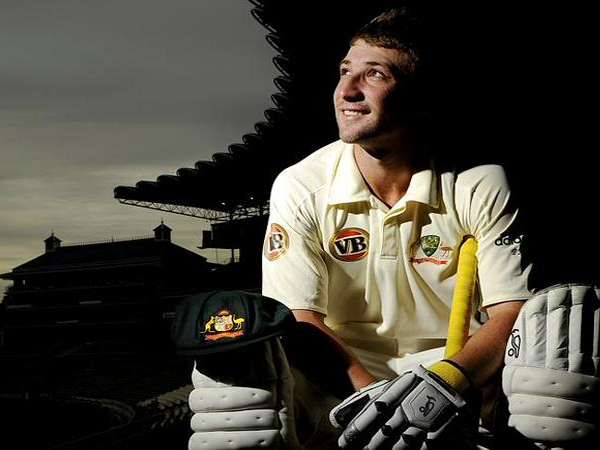Australian cricketer Phillip Hughes has tragically passed away two days after being struck by a bouncer while batting for South Australia in a Sheffield Shield game at the SCG.
Hughes had scored 63 not out against his former state New South Wales and was making a strong case for a recall to the Australian test side when a Sean Abbott bouncer hit Hughes behind his left ear at 2:23pm on Tuesday, 25th November.
Hughes, at the time five days shy of his 26th birthday, stayed on his feet momentarily, before collapsing, unconscious, face first into the turf.
NSW team doctor John Orchard performed CPR on Hughes pitchside, on the medicab that was called, and behind a sheet held up by players boundary side at the SCG.
The NSW players on the pitch seemed to immediately grasp the gravity of the situation, with David Warner and Brad Haddin putting Hughes into the brace position, while Abbott cradled his head.
Hughes was rushed to St. Vincent’s Hospital for emergency surgery to relieve swelling on his brain.
Because of the medical nature of the situation – and perhaps in part due to the omerta inherent to professional sports outfits – little news filtered through.
The next two days became a concerning non-stop montage of ashen-faced players and officials arriving at the hospital and leaving visibly distraught. Veteran sports journalists like Peter Lalor, Ben Dorries and Jim Maxwell were also openly distressed while filing reports.
Michael Clarke, Australian captain and one of Hughes’s closest friends in the game, was ever present, leaving the hospital late on Tuesday and Wednesday nights, and coming back early the next mornings.
All of this support, however, could not help Hughes, and unfortunately he lost his fight at around 3:30pm on the 27th of November, having never regained consciousness after being struck.
Not much solace when young people die, but Hughes lost consciousness at a place that he loved, doing what he loved. That’s not nothing. — Ben Mckelvey (@benmckelvey) November 27, 2014
There will be, as there always is after an tragedy, questions to answer. Could the ambulance have gotten Hughes to the hospital quicker? Could a more up to date helmet have prevented the hit that ultimately killed Hughes? Should next week’s first test against India be rescheduled?
The bottom line is that none of this matters. Right now all focus must be on Hughes’s team mates past and present; Sean Abbott, who will be feeling this more keenly than anyone; and most importantly Hughes’s family, father Greg, mother Virginia, and siblings Megan and Jason, who drove down to Sydney from their home in Macksville to be by Phillip’s bedside.
Macksville, a town halfway between Brisbane and Sydney, had a huge part to play in Hughes’s development, both as a cricketer and as a person.
Hughes had the classic personality of a country boy; he was laid-back and personable, he took setbacks in his stride.
His response to being asked if he was frustrated at not being able to force his way back into the test side was to smile and say that he had plenty of time to get there – a classic response from a young country lad with a “she’ll be right” attitude.
Hughes also developed his idiosyncratic batting style on the family banana plantation in Macksville. To the left-handed Hughes, the family home was on the leg-side. Not wanting to risk the wrath of his mother, Hughes learned to position his body to play as many balls as possible to the off-side.
His homespun technique worked in his favour; he scored runs prodigiously as a junior and forced his way into the NSW Sheffield Shield side for a debut just ten days shy of his 19th birthday.
That first month of his Test career in South Africa is something we’ll all remember. RIP pic.twitter.com/V3wAR5u9Nn
— Russell Jackson (@rustyjacko) November 27, 2014
Hughes made a fifty on his first-class debut, and fifteen months later played his first test at 20 on Australia’s tour of South Africa. His very first test innings ended in a duck, but in his second test at Durban Hughes made a mockery of South Africa’s world class bowling attack, plundering a century in each innings – a rare feat at test level, especially for one so young.
When Hughes impudently brought up his maiden test century with consecutive towering sixes off South African spinner Paul Harris, it appeared the sky was the limit for the young man.
However, his technical issues were soon to be found out. On the subsequent Ashes tour, the English fast bowlers exposed an inability to deal with short deliveries. Hughes found himself out of the test side just three matches after his feat in South Africa.
This started a cycle of Hughes being dropped and reinstated; most recently Hughes played the first two tests of the ill-fated English Ashes of 2013 before being once again losing his place.
Meanwhile, Hughes continued to rack up incredible statistics at first-class level, keeping his name in front of the test selectors’ eyes – 9,023 runs at an average of 46.51 with 26 centuries remarkable figures for any player; astonishing when considering Hughes was not yet 26 years of age.
In a sporting sense, the tragedy is that Hughes’s test career has arguably been defined more by the tumult surrounding his spot in the side than his blazing entrance.
At roughly the time Sean Abbott was bowling that fateful delivery, Cricket Australia were reportedly drafting a press release to state that Michael Clarke would miss the first test of the India series at the Gabba.
Hughes was considered a front runner to take Clarke’s spot. Still so young, he had the chance to redefine his own legacy.
In a human sense, the tragedy is that he no longer can.
Rudi Edsall is a first year Bachelor of Journalism (Sport) student studying at La Trobe University. You can follow him on Twitter: @RudiEdsall







